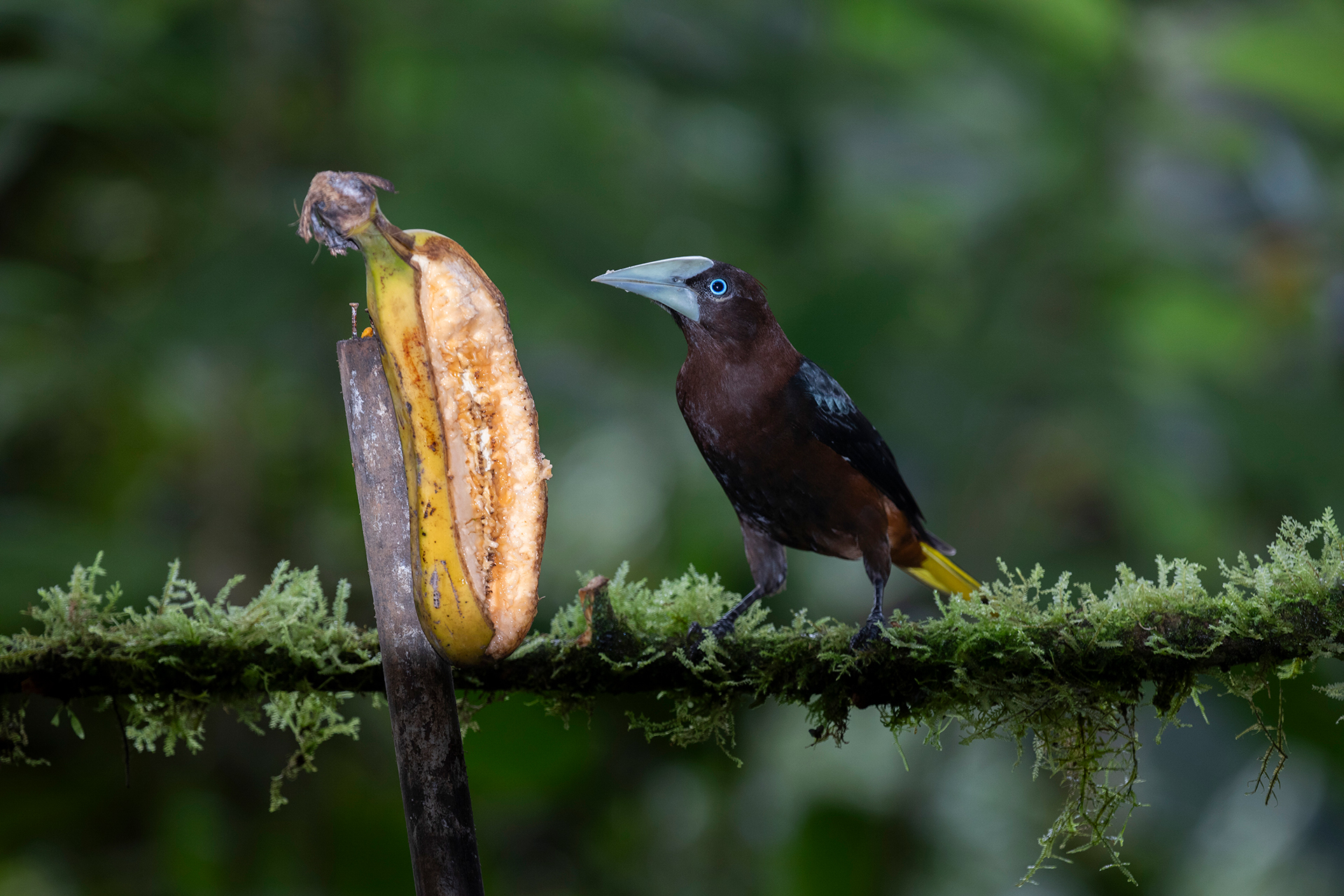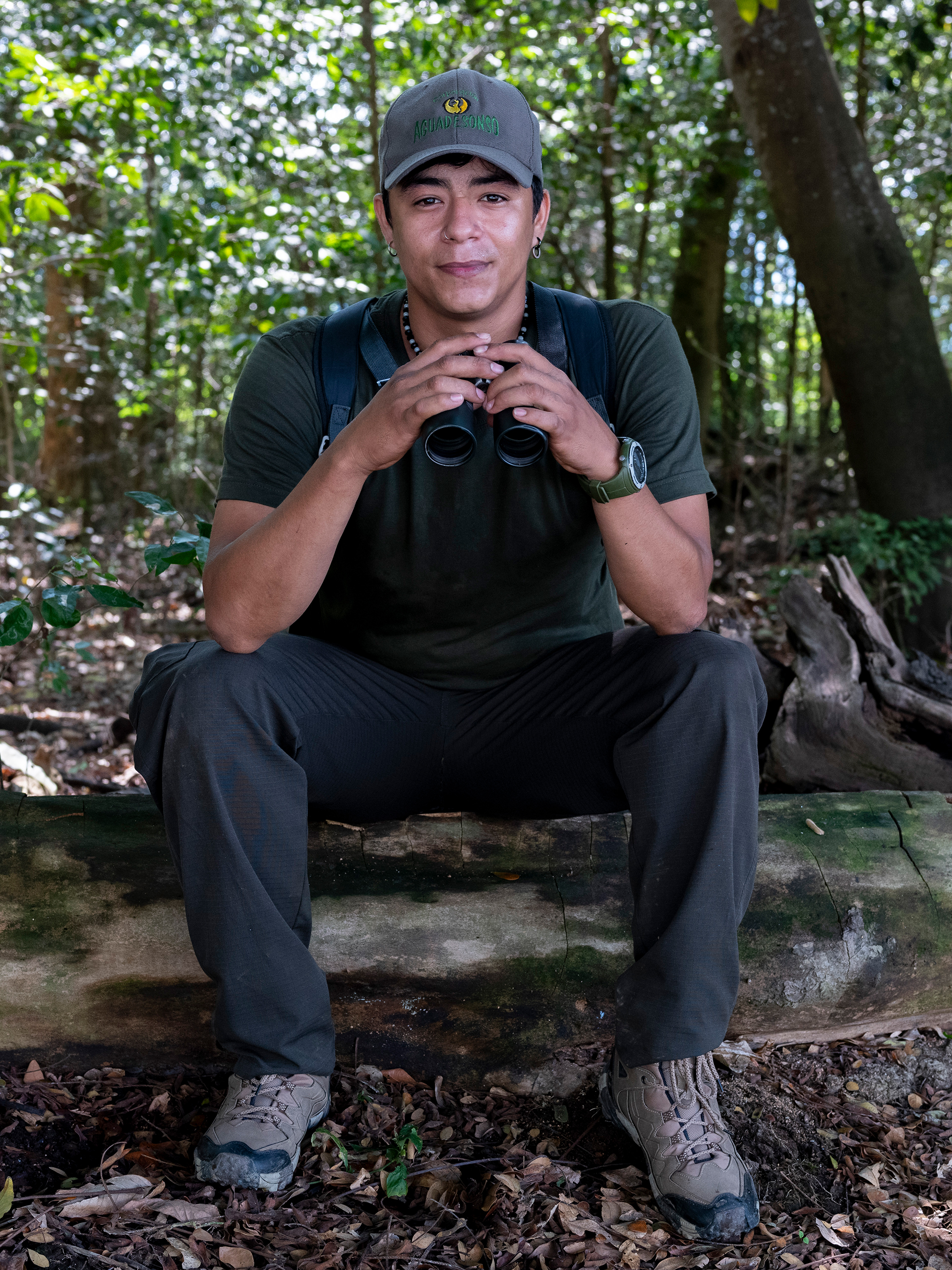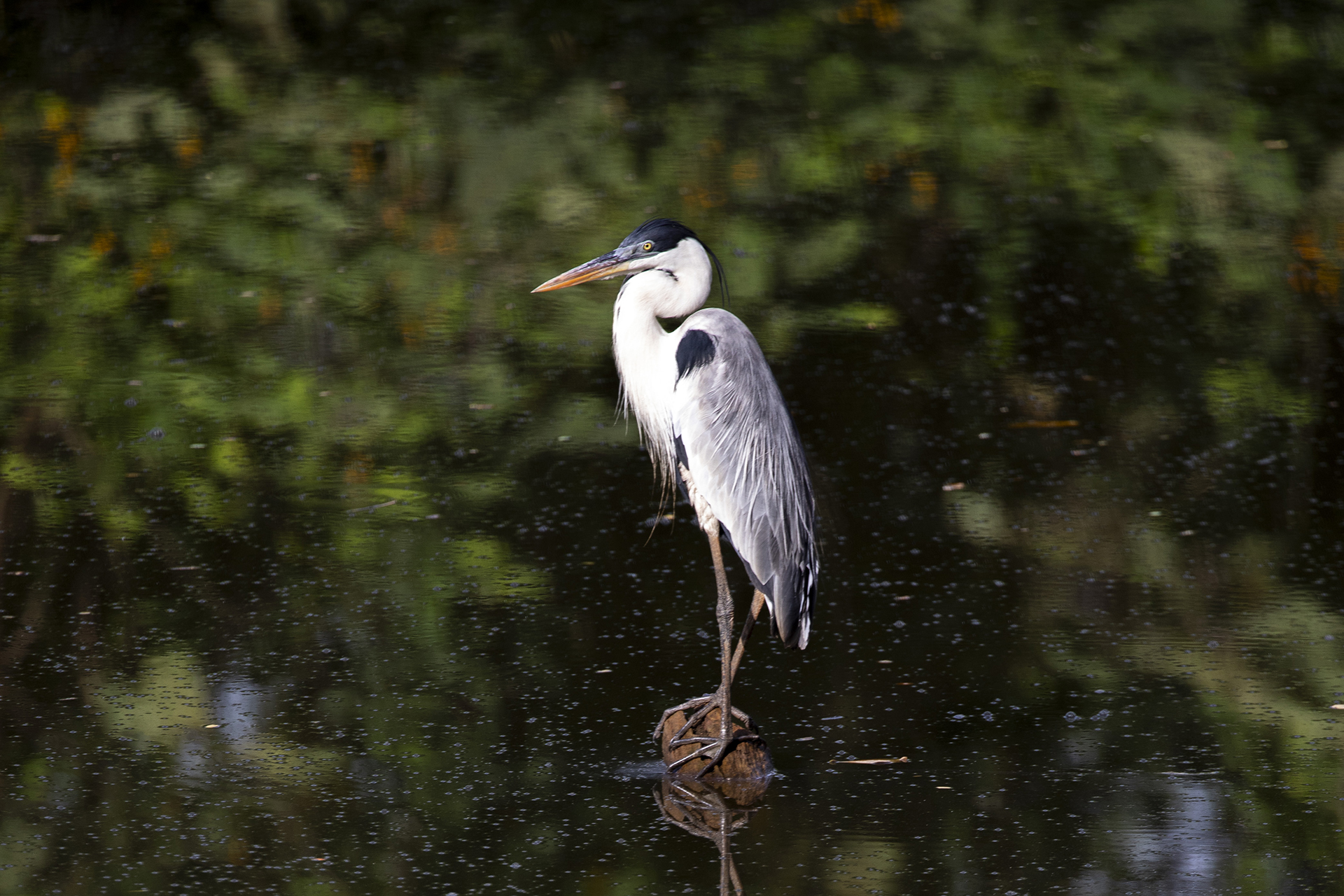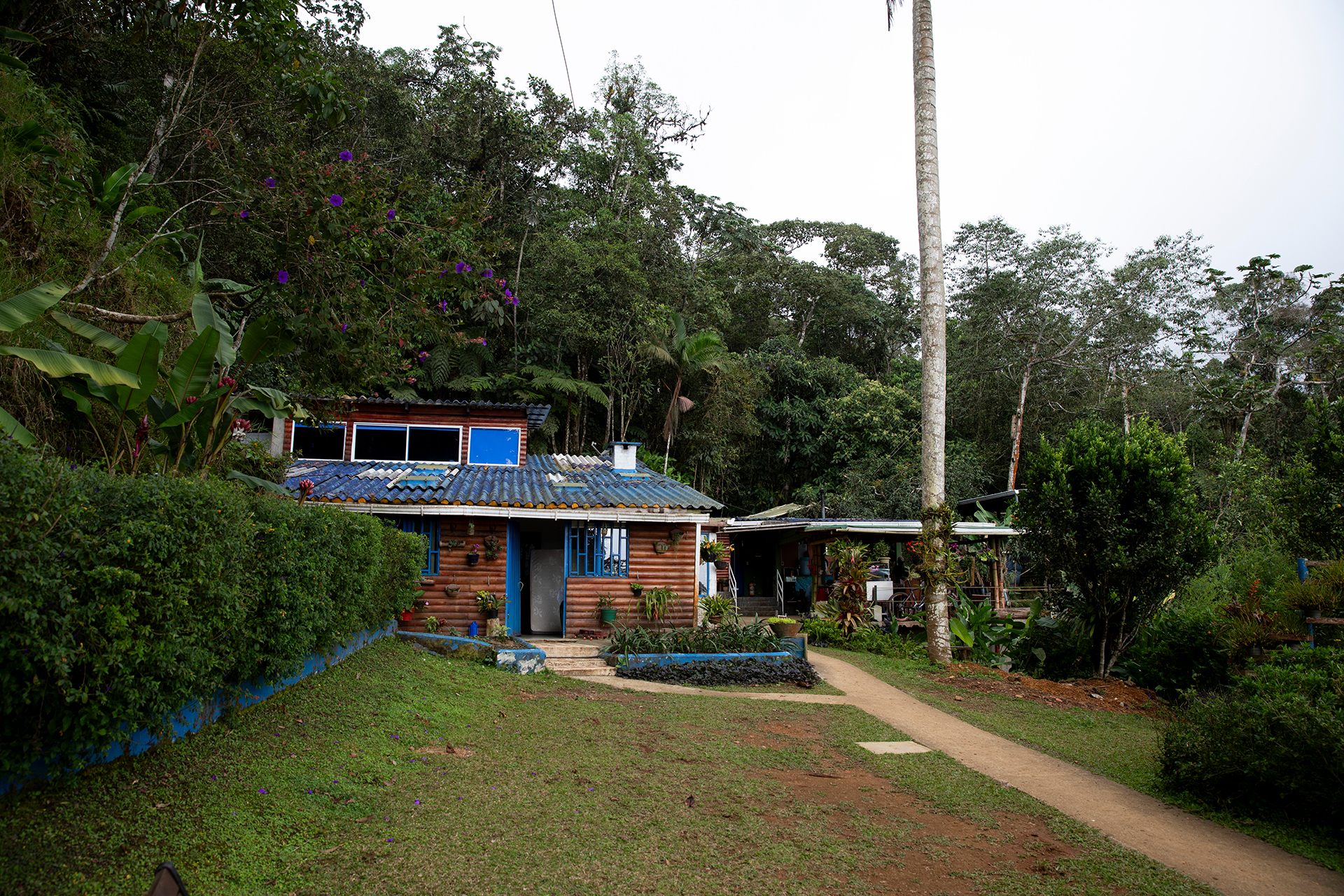Why thousands of people are traveling to one country to see these birds
15 min readHaga clic aquí para leer esta historia en español.
VALLE DEL CAUCA, Colombia — From the side of an old highway that cuts through the Andean foothills, Dora Alicia Londoño’s home looks unremarkable. Located in a rural area about two hours from Cali, the largest city in southern Colombia, it’s a simple, two-story concrete building with a sheet metal roof. A few potted plants hang from the rafters.
The main attraction is in her backyard.
There, you will find birds. So many birds. And these are not just your common backyard varieties, like robins and bluejays, but rare forest species that birdwatchers around the world yearn to see.
Londoño, 63, has turned her home into a birdwatching lodge, a paradise. There are five guest rooms and a cafe with a view into her backyard, a dense tropical forest. There, she has a homemade bird feeder: wooden shelves holding pieces of fruit. Upstairs, on the roof, she had additional feeders for hummingbirds.
When I visited on a warm morning in October, it felt like stepping into a nature documentary. The backyard was teeming with birds, none of which I’d seen before: glistening green mountain tanagers, toucan barbets, lemon-browed flycatchers, velvet-purple coronets. These birds were so colorful they almost looked unreal, painting the yard with streaks of yellows, reds, blues, and purples. And then there was the noise — a clamor of cheeps, trills, and squawks.
“The toucan barbet is one of the rarest birds in the world and it just eats bananas right here,” said Natalia Ocampo-Peñuela, a Colombian-born conservation ecologist and bird expert at the University of California Santa Cruz, who was at Londoño’s with me that morning. In an hour or so, I saw about 45 different species, Ocampo-Peñuela estimates, while leisurely sipping coffee and eating empanadas. If this is birdwatching, I’m in.
If you’re into birds, Colombia is the place to be. It has more avian species than any other country on Earth, with close to 2,000 distinct and often very beautiful varieties, nearly 20 percent of the world’s birds. That diversity is rooted in geography. Colombia is a mosaic of different habitats, from tropical rainforest to snow-capped mountains, and different birds have adapted to each of them. And as I experienced that morning, birding here can be incredibly easy. You don’t even need hiking shoes.
This isn’t much of a secret. In the last decade, the activity of birdwatching has exploded in Colombia, said Ocampo-Peñuela, who also studies ecotourism. Activity on eBird, a platform where birders can record their observations, increased more than 27-fold in Colombia since 2010, according to unpublished research by Ocampo-Peñuela and other authors that’s currently under review. While the bulk of these birders are foreigners from places like the US and Canada, more and more Colombians are picking up the hobby, too, she said.
This burgeoning industry is, as many experts argue, a rare force of good. It’s funneling money into rural communities and creating material value for healthy forests — something the environmental movement has, for decades, struggled to do. Indeed, at a time when tropical forests and grasslands are besieged by farming, mining, and other threats, birdwatching tourism offers a real incentive to keep ecosystems intact. Without forests, there are no birds, no birders, and no birding tourism.
There are, no doubt, concerns about sustainability as this young industry matures and more foreign tourists descend on Colombia. But for now, local communities are at the helm of this industry, which is good for people, good for the local economy, and good for wildlife. They intend to keep it that way.
Londoño, who goes by Doña Dora, didn’t dream of running a birdwatching lodge and welcoming tourists into her backyard. In the 1990s, she moved here, to the outskirts of Cali, to escape violence near her home in the tropical grasslands, known as Los Llanos. This story is not uncommon. A decades-long conflict between armed groups and the government has displaced more than 5 million people across the country.
Doña Dora arrived with nothing, she told me that morning, as we watched hummingbirds flutter around a pair of freshly filled feeders like a collection of airborne jewels. She cleaned homes and sold empanadas on the side of the road. Her husband picked up odd jobs.
Then one day she went to the dentist, and her life changed.
Her dentist, a man named Gilberto Collazos Bolaños, was a bird fanatic, and he knew the forest around her home was full of avian life. So he gave her a suggestion: Put some fruit on a table outside, and wait. The fruit will draw in birds, she remembers him saying, the birds will attract tourists, and the tourists will bring in money.
She took his advice. And birds came. First there were bluebirds, golden tanagers, and colorful finches called euphonias. Then rarer species like rufous-throated tanagers and toucan barbets arrived. Toucan barbets are the unequivocal stars of the show. Found only in the mountain forests of western Colombia and Ecuador, they have a brilliant plumage — a collection of light gray, red, yellow, and black — and a song that sounds a bit like a frog.
As the dentist predicted, birders eventually arrived, too, largely finding her home by word of mouth. And in 2015, Colombia hosted its first annual BirdFair, a major birding festival, and one of the event’s official field trips was a visit to Doña Dora’s home. That put her on the map, she told me.
“We always loved nature and trees,” said Doña Dora, who, when I visited, was wearing a head covering and what looked like a white lab coat. “But we didn’t have a vision for what we have right now, of birdwatching.”
Today, her home is considered one of the country’s top birdwatching destinations, and some visitors have dubbed it “the best backyard birding spot in the world.” It’s this birding business that now supports her family.
Foreign tourists pay about $9 to view birds on her property ($13 if they have a camera). A room for two people is around $50 per night, which doesn’t include her coffee or her homemade empanadas. In the busy season, from September to March, the lodge will get more than 100 tourists a month, according to her son Elber Sanchez Londoño, who helps run the business.
In her backyard that morning, I watched birds. But I also watched birdwatchers watch birds. I honestly found this activity just as thrilling.
What is it that makes some people so obsessed with birds? One explanation is that you can find them pretty much everywhere. That makes birdwatching easy to start and practice, no matter where you live. Birding can also connect you to a community. It tends to bring like-minded people together, both in person and through platforms like eBird and iNaturalist, where they can share their observations. Plus, it’s free and done outdoors, which is one reason why birding became so popular during the Covid-19 pandemic when people were avoiding crowded, indoor spaces.
“It’s like an addiction,” Ocampo-Peñuela, a self-identified birder, told me. “You see these birds, and their beauty, and it just fills you with happy hormones. Then you want to do it more.”
That morning, I met several tourists at Doña Dora’s lodge. Most of them toted cameras with long lenses. “This is unbelievable,” said Santiago Ferro, a visitor from Toronto, who grew up in Bogotá. I asked him how this spot compares to birding in North America. He just laughed.
Birders are drawn to Colombia for its sheer number of avian species, many of which are found nowhere else. But the ongoing surge in birding tourism has far more to do with safety.
Until recently, a conflict between the government and a number of armed groups spread violence across Colombia. At the center of the conflict — which began in the mid-20th century — was the distribution of wealth. The largest such group, Fuerzas Armadas Revolucionarias de Colombia (FARC), fought against the government and right-wing paramilitary groups to bring more wealth to poor rural parts of Colombia. Violence tied to the conflict killed more than 200,000 people, and most of them were civilians.
In 2016, after years of tense negotiations, the government and FARC signed a peace agreement. Put simply, the agreement required that FARC give up their weapons, stop fighting, and exit the drug trade, which was helping fund the conflict. In return they were offered political power and a promise to invest heavily in rural areas.
Violence still persists in some regions, especially near the borders, and the US State Department advises people to reconsider traveling to Colombia. Yet a tenuous truce holds. The peace agreement has made the country much safer, for locals and foreigners alike, than it has been for decades — and that, in turn, has opened the door to more birdwatching tourism.
In 2017, Ocampo-Peñuela published a study showing that birdwatching, as measured by activity on eBird, was already expanding in areas that were once considered dangerous, including Putumayo, a department in southern Colombia. Ocampo-Peñuela’s more recent research, which is not yet published, finds that birdwatching activity skyrocketed in Colombia after 2016, though it dipped during the pandemic. (A large portion of eBird users are from the US, so data from the platform over-represents American birding trends.)
The government doesn’t track birdwatching activity, though it says tourism overall is climbing. Last year, a record 6.1 million foreigners visited Colombia, up 30 percent from 2022, and the majority of them are looking for nature experiences, according to Procolombia, a government agency that markets the country. Tourism is already up this year compared to 2023, Procolombia told Vox. And since 2021, the number of nature lodges, including birding lodges, has nearly tripled, the agency said.
In global hot spots of biodiversity like Colombia, economic growth often comes at the expense of ecosystems. A growing cattle-ranching industry destroys rainforests. A mining boom leaches toxins into streams and soil. Comparatively, Colombia’s ballooning birdwatching industry seems like something to celebrate.
Tourism is not only funding birdwatching destinations like Doña Dora’s but building demand for local birdwatching guides. That’s created jobs for Colombians with deep ties to their surrounding ecosystems, whether or not they have a formal education. Generational knowledge of local birds and where to find them — referred to in some academic circles as traditional ecological knowledge — is increasingly valuable here, even in a straight economic sense. Birdwatching tourism gives it value.
The following morning, I traveled to a place called Laguna de Sonso, a wetland just north of Cali. It’s a blip of natural habitat in a sea of sugarcane plantations, a widespread crop in Valle del Cauca. When I arrived, a cocoi heron, a large gray and white bird with a long, sharp beak, was wading in the water, sending ripples out across a lake.
The wetland is a birder’s dream. More than 300 avian species live in or pass through Laguna de Sonso, including giants like the osprey and weirdos like the common potoo, a bird with an unsettlingly wide mouth.
It’s also where youth from the surrounding communities learn to become birdwatching guides, or interpreters, as they call themselves. “We call ourselves interpreters because we are a community that has had empirical training,” said local guide Jhonathan Estiven Bedoya Betancourth, meaning they’ve learned through observation and experience. “We do not have, let’s say, the training of a professional tourist guide.” (A pair of community organizations at Laguna de Sonso do offer workshops and mentorship for bird guiding.)
Bedoya Betancourth, 24, says he’s been guiding birdwatching tours since he was 14. “We interpret everything that this beautiful territory has,” said Bedoya Betancourth, who wore a pair of binoculars around his neck.
Bedoya Betancourth started guiding because he loves birds, and he’s good at it. He can imitate the calls of around 30 species, he said. (I obviously asked him to demonstrate, and he impressively whistled the repetitive up-and-down call of a marsh bird called the gray-cowled wood-rail.) But it was also a way to earn money for his family, he said. He makes about $35 for each guiding trip, not including tip, and he’ll lead several trips a month. He supplements his income by making wood carvings to sell to tourists and locals.
“Birdwatching for me and for the group of interpreters is one of the economic activities that has been able to keep the community afloat,” said Maria Omaira Rendon Rayo, a community leader at Laguna de Sonso.
The birding economy gives people a reason to stay in the community, she said, and offers an alternative to careers that might attract violence, such as cultivating and selling drugs. By training kids, the laguna and its community organizations are also helping build a conservation ethic that will last for decades.
“If you are receiving economic income from an activity such as conservation, then you want to conserve more,” said Rendon Rayo, who works with a local organization called Asociación de Productores Agropecuarios del Porvenir, which helps restore forests by planting trees and trains birding guides in Laguna de Sonso. “You want to help plant more trees. You want to help keep the laguna clean.”
Nature tourism is not an unequivocal force of good. It actually often harms the environment, as researchers like Ralf Buckley have documented. Tourists have inadvertently introduced invasive species to places like the Galapagos Islands, snorkelers and divers have damaged coral, including in the Great Barrier Reef, and hotels are commonly built atop natural habitat. There’s also an exploitation issue: In many cases tourism companies are owned by foreigners, limiting the benefits that flow to local communities, on which they often depend. Plus, as a place swells with wealthy tourists, the cost of necessities like housing and food can rise, making it unlivable for locals.
Birdwatching tourism in Colombia has so far managed to avoid many of these pitfalls. It has some guardrails built in, Ocampo-Peñuela said. For one, birding doesn’t work well in large groups — they scare away birds and make it hard to spot something fluttering far away — and smaller groups have a lighter environmental impact. One of the lodges I visited capped the number of tourists to 10. Another said there are days when they will turn visitors away.
What’s more is that finding rare and endemic species, which birders are most drawn to, typically requires local expertise. That helps keep money within local communities.
Then there’s the most important guardrail: Birdwatching tourism doesn’t work if it’s not sustainable. Even if you put out fruit, the birds won’t come if they have no habitat — no forest, no wetland. Birding is not like going to the zoo, where you can always expect to see animals. It’s in the economic interest of the birdwatching industry to make sure ecosystems remain healthy.
“You can’t do this business without conserving,” Javier Rubio, who runs another birdwatching destination, called La Florida, at his property northwest of Cali. “If you don’t conserve, you put your future as a business at risk. If you start cutting down trees and damaging the forest, [the birds] will be left without food, which is the reason why they are here.”
Doña Dora says one of her goals is to earn enough money so that her son can buy forested land around their home. He wants to conserve it, she told me. “That’s the idea for the future,” Elber, her son, told me, “to make sure that the birds continue to live in a healthy ecosystem.”
The industry is still young, so the full extent of its environmental impact has yet to be seen. People involved in growing birdwatching tourism say it’s critical that Colombians, and especially people in rural, bird-filled regions, determine what the industry ultimately looks like. “It’s necessary that we Colombians define what kind of birdwatching tourism we want,” said Carlos Mario Wagner, the founder and director of Colombia BirdFair and one of the country’s most well-known birders.
Birding tourism shouldn’t just cater to foreigners, he said, but also to locals. “Something that makes me very happy is that Colombians are increasingly hiring guides,” Wagner told me. Birding has given Colombians an opportunity to reconnect with their homeland following the peace agreement, he said. It instills in them a sense of pride for a version of Colombia that’s known for nature, not violence.
The birding industry will ultimately never be huge, Ocampo-Peñuela says. While it’s growing globally — faster than other forms of ecotourism, she’s found — it will likely remain niche, limited by the small number of people who want to travel to rural places to look at birds, often very early in the morning. “You have to have the right personality,” she told me.
So it’s not like birdwatching alone will fix Colombia’s problems and raise the rural class out of poverty.
Yet what it offers is incredibly special. Not just money for local communities, alternative career paths, and real incentives to save forests, but also something that’s harder to quantify.
On a rainy afternoon in October, I visited Rubio at La Florida. Like Doña Dora, Rubio has a homemade bird feeder in his yard constructed with branches and pieces of fruit. It attracted a different cast of avian visitors. Here, the star was the multicolored tanager, a colorful species found only in the mountain forests of Colombia. My favorite, however, was the crimson-rumped toucanet, which is essentially a mini toucan. They’re bright green with rust-colored beaks that seem far too big for their bodies.
Over my fourth cup of black coffee, Rubio told me he was a criminal lawyer for nearly three decades before getting into the birdwatching business. A few years ago, he invited friends to his home to go birding. They saw the multicolored tanager and told him that his property — which abuts a tropical forest — has enormous potential to become a birdwatching destination.
Eager to live a more relaxing life, Rubio, 56, quit his job as a lawyer and started building a tourism business.
“I feel extremely good doing this,” Rubio told me. “I often feel like I’m giving happiness to people. Almost unanimously the people who come say, ‘This is a paradise.’ When you start birdwatching, you start to feel attracted not only to birds but to the peaceful environment of nature.”
This is a point that nearly every birder I spoke to made: Caring about birds is a gateway to caring about nature, of seeing its true worth.
“It is a gradual process,” Rubio told me, as we sat on a covered deck as it rained, watching a multicolored tanager bounce around in the branches a few feet away. “You first contemplate them, then you begin to understand them, and then you begin to preserve them. That is the path taken by the one who takes up this habit of birdwatching.”






















